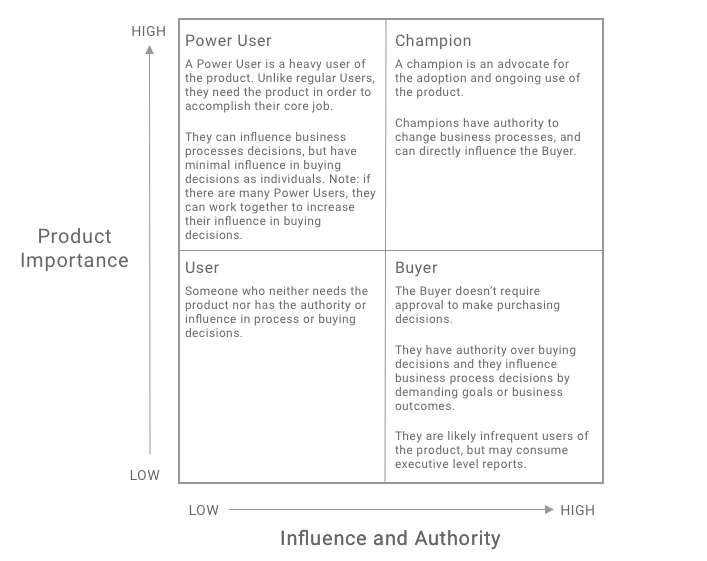Many of us recall the “old days” when software was sold on a CD or DVD. Post-sale activities were managed by Account Management, “renewals” were new versions of the software, and buying roles were much simpler and easier to understand:
- Vice Presidents had the power to buy products.
- Directors had influence in the buying decision.
- Individual contributors were the end users and didn’t have an important role.
But as software transitioned to the cloud, and as product-led growth became a more popular way for companies to adopt new software, these definitions fell short. They failed to capture new factors in buying processes like levels of authority, influence in decision making, and product usage.
What emerged were 3 new roles:
- Buyers
- Champions
- Power Users
These new names captured factors in modern buying processes, but for those of us that didn’t grow our careers through Account Management, made it harder to understand what each role means.
Clarifying what each new modern role means
To get a better understanding of what these terms mean, it’s helpful to compare them to each other. The graphic below helps visualize how the Champion, Buyer, and Power User roles are different by looking at their Influence and Authority, and their Product Importance.

Influence and Authority defined (x-axis)
Influence is the weight of a person’s opinion in the mind of the decision maker. Influence often comes from a small number of high ranking people, or a large number of low ranking people.
Authority is the power to make final decisions without approval from someone else.
Product Importance defined (y-axis)
This measures how critical the product is to accomplish the user’s job. If the product is of low importance, the user can replace or work around the product. If the product is of high importance, the user requires the product to perform their core job.
This quadrant does not include...:
We opted against using Advocacy, Budget, and Volume of Usage as factors for this quadrant because they don’t help define the difference between user types:
- Advocacy is a measurement of endorsement , and anyone could be an advocate
- Only one user has budget authority, so it’s not a meaningful differentiator.
- Frequent Usage has minimal correlation to value received for many products, and any role could have high or low frequency usage
What you can detect using these definitions
Using these definitions with your team will allow you to:
- Detect when a user is not a power user. When looking at product usage, power users and users appear the same. But there’s risk in counting them the same: for a user, who doesn’t need the product to get their core job done, the product could easily be replaced. By focusing on building users into power users, CSMs reduce churn risk. Identifying the power users in an account can also guide product decisions: if the product is missing a feature that’s needed for the power user to reach their desired outcome, that feature needs to be prioritized.
- Determine whether an advocate is a champion. To be a champion, an advocate needs to have Influence over the buying decision and Authority over the process. If they don’t have those two attributes, they won’t be very helpful in purchasing, upgrading, or implementing your product.
- Know where to focus your time to build more fruitful relationships. These definitions should help CSMs identify good candidates for power users and champions.

The top articles this week:
This week's newsletter features posts on:
- Stop Calling Churn a Customer Success Problem
- Customer Experience Isn't Just Tech Jargon
- Four Ways Good Leaders Become Great Ones
- Words and Phrases Top Success Reps Use
STRATEGY
Let's Stop Calling Churn a Customer Success Problem
Kyle Poyar, VP - Market Strategy at OpenView, with 8 things that Sales, Marketing, and Product can do, with the help of Customer Success, to move the needle on churn.
CULTURE
Customer Experience Isn't Just Tech Jargon
Emilia D’Anzica, Customer Success Consultant (former CCO at Copper), shares advice on building a customer-centric business.
LEADERSHIP
Four Ways Good Leaders Become Great Ones
Ed Batista, Executive Coach, with a concise piece on four attributes that differentiate good leaders from great ones. Of the four, I’d call out “Understand the symbolism of leadership.” He says, “People join organizations and feel committed to them to a certain extent because of the feeling of community... and because of the leader's commitment to invest in the health, development, and growth of that community… it’s important to recognize that a leader bears a unique responsibility to help the community feel a sense of collective identity and growth.”
RESEARCH
Words and Phrases That Top Sales and Success Reps Use
Gong analyzed over 500k sales calls to share the words and phrases top performers regularly use. Worth sharing this with the team to try out.





Submit a comment